#the idea of inherent worth? in MY fairytale? it’s more likely than you think
Explore tagged Tumblr posts
Text
“pinocchio never needed to become a real boy because he was worthy just for being born” is not the take i thought that would come out of the 21st century but it is a refreshing one
#lies of p#guillermo del toro’s pinocchio#textpost#the idea of inherent worth? in MY fairytale? it’s more likely than you think#its giving attack on titan vibes
47 notes
·
View notes
Text
A Revival & New direction for my blog
I haven't posted in a while, but here I am!
I have decided to basically dump my ideas here, because I have tonnes!
I hope to write long, rambly yet entertaining posts about my opinions focusing on fashion, sustainability and finances/anti-capitalism/anti-consumerism (as it connects to my life). It'll still incorporate my other interests too of course.
Fashion
What do I mean by 'Fashion'?
I mean in the development of my personal wardrobe. Those who know me IRL know that I am a fashionable individual, however, upon recent reflection I realise there's too much mainstream ideals that I may, sadly, only be following because everyone else is doing.
However, in saying that, I love a lot of my wardrobe and I'd never let a single piece in that I didn't have an appreciation or practical application for.
I really want to take a more historically inspired approach. Drawing from the 1900's (duh) but also, the 1800's and possibly even before 👀
My biggest focuses are Victorian, Edwardian, regency and
"what did the peasants wear? Because if it was good enough for them, it's certainly good enough for me!"
In more modern/broad ways, I will be drawing from
Lolita/J-Fashion
Gothic Fashion, mainly romantic but also many other subgenres.
Mermaids (not inherently 'mermaidcore' because I think that's a bit of a diluted version of what I seek)
Princesses in fairytales
Angels
Fairy's (again, not so much Fairycore because it really isn't resonating with my current vision)
This isn't to say you'll never see me reblog a post that has a #fairycore or anything, because I understand that people use hashtags for exposure. But also, that the 'core' versions of this aren't inherently bad! Just that's not the terms I would use to reflect myself.
Sustainability & Anti-consumerism
There's too much shit in the world. I go into H&M for a browse and it's just shitter versions of things that have always existed. For example, there's surely enjoy beige trenchcoats in the world. I recently saw that viral post of some celebrity from the 90's in a fishing jumper and a modern celebrity and like many other people, the quality difference shocked and appalled me.
In saying that and in the name of transparency, I will admit, I did do a Shien order. I feel guilty about this, but I also hope that any readers know that I do about one Shien order a year and it's no more than €100 worth of things. The things I ordered are also pieces that you generally can't get second hand. For example, tights (because they usually get super gross or break.
I am a firm believer that DIY and repair is punk. I don't really like a lot of punk fashion, so I'm not putting it in my list but just know I identify with many of the ideals and that I am striving to incorporate more of it into my life. For example, I've been using invisible repair methods a lot more on my own personal clothes. My family have said that it's pointless because the items I'm repairing cost cents to replace and maybe they have a point, but I find the repair process relaxing and a sign of love.
Finances and Cost
As you'll soon discover, I am not a particularly wealthy individual. For the sake of my privacy, I'll avoid details.
It's easy to say “I want to dress Goth and Victorian” then buy a few designer or custom corsets and call it a day, but I don't quite have that financial privilege.
However, if I budget for certain items that I know I will get excellent use from, I can make it work.
I'm not very good with money. It burns a hole in my pocket, but I'm making a conscious effort to change that. I will be posting reviews of my incoming orders and possibly some of my previous purchases.
Why now?
CW mention of weight loss and some numbers (in regards to sizes) for this section
Note: I will be adding CWs above paragraphs relating to anything weight or body changes related
As it's sure to come up eventually, I'll answer the question. I've been on a weight loss journey starting at about a UK18/US12, I strongly identified as plus size and I'm currently a little more than a UK12/US8 with plans to get down to about a UK8/US4. My old reliables don't fit me, and they won't fit me in the future. So I NEED to buy more things.
I hope to write somewhere about my identity as a plus size woman no longer applying.
Currently, when I am getting dressed and exploring what my wardrobe has to offer, it saddens me. Because I know that a lot of my favourite pieces don't work. I've given many away to good homes but I still miss them.
If I have to turn over a new leaf, I may as well march into the future with ambitious ideas.
Historical fashion is generally very adjustable which as my weight continues to change, I really need.
Because of my low budget and good taste, it doesn't make sense for me to buy things that may not fit me in a few months. This means that most things I buy I either need to be
Ok with getting rid of (ie. Giving away to a good home)
Forgiving fit (eg. Stretchy or 'oversize')
Easy to take in (eg. Adding a fold to a ruffled skirt)
If anyone has any ideas on how to make various items of clothes last, please do let me know and I'll see where I can go with it.
Thanks for reading!
Hopefully, you like it! And if not, then vanish into the abyss or just block me. This blog is mostly just as an outlet for my scatter brain.
#new era#fashion#historical fashion#fashion opinions#unmellow opinions#intrinsic motivation#follow or don't#anti capitalism#anti consumerist#alternative fashion#alternative fashion blog#im back
0 notes
Text
If there’s a reason why we’re able to recall the story of Snow White from memory, and why said princess is usually depicted with short hair, a cute bow and surrounded by woodland fauna, look no further than Disney. Their take on the Grimms’ fairy tale is the prime example of pop cultural osmosis. Even if you’ve never watched Disney’s Snow White, it’s easy to recognize when a piece of work is borrowing from it or spoofing it. And I can definitely see why – not only is it going eighty-plus years strong, but its influence on nearly every Disney feature to come after it is a profound one.
The real story of Disney’s Snow White begins in the early 1910’s when a young Walt Disney saw a silent film version of the Grimms’ fairytale starring Marguerite Clark. The movie stuck with him well into adulthood. One night, well after he had established himself as an animation giant the world over, Walt gathered his entire staff of animators and storymen and re-enacted the tale for them in a mesmerizing one-man show. They were enraptured, but what he told them next struck them dumb – they were going to take what he performed and turn it into a full-length film.
In Tony Goldmark’s epic(ally hilarious) retrospective of Epcot, he performs a quick sketch he summed up as “Walt Disney’s entire career in 55 seconds” where Walt presents his career-defining ideas to a myopic businessman capable of only saying “You fool, that’ll never work!”. Considering how animation is everywhere today, it’s easy to forget that an animated film was once seen as an impossible dream. The press hawked Snow White as “Disney’s Folly”, and Hollywood speculated that it would bankrupt the Mouse House. It very nearly did. Miraculously, a private showing of the half-finished feature to a banking firm impressed the investors enough to ensure its completion.
Snow White is touted as the very first animated movie – admittedly something of a lie on Disney’s behalf. Europe and Russia were experimenting with feature-length animation decades before Walt gave it a try. But consider this: most animated films predating Snow White’s conception are either sadly lost to us or barely count as such by just crossing the hour mark. With all the hard work poured into it showing in every scene, with each moment displaying a new breakthrough in the medium, Snow White might as well be the first completely animated movie after all. Hell, it’s the very first movie in the entire history of cinema that was created using STORYBOARDS. A tool used by virtually every single movie put out today. If that’s not groundbreaking enough, I don’t know what is.
But is Snow White really…but why does it…can it…

“You know what? No. I’m not doing this teasing question thing before the review starts proper. OF COURSE Snow White is a masterpiece. OF COURSE most of it holds up. Let’s skip the middleman so I can explain why.”
After the opening credits we get the first of what will be many Disney leather bound books opening themselves to invite us into the world of the story. We’re informed that once upon a time there was a particularly Wicked Queen (nicknamed Grimhilde in promo features and the comics) who had a serious narcissistic personality disorder. Every day she consults her Magic Mirror™ to see who’s the fairest one of all and takes pride in being repeatedly told she holds said title. In the meantime she bullies her younger, prettier stepdaughter, the princess Snow White, and gives her the standard Cinderella treatment in the hopes that endless drudgery will wipe out the competition.
One fateful morning, however, the Mirror informs the Queen that she’s been bumped down to runner-up. She susses out that it’s Snow White who’s taken her place after the Mirror describes the newcomer as having “lips red as the rose, hair black as ebony, [and] skin white as snow”, but maybe the Queen is projecting here due to her extreme jealousy. Going by those three traits the Mirror could be describing almost anyone on the planet.

Care to narrow it down a bit, buddy?
Now if you consider yourself a feminist or at the very least have progressive views regarding women, I know what you’re thinking – just another example of the patriarchy pitting shallow female stereotypes against each other, right? Well in a manner of speaking, yes. There’s plenty of evidence that the Brothers Grimm held some odious misogynistic beliefs that stemmed from a bad combination of the era they lived in, outdated religious teachings, and their own experiences with the opposite sex. It shows in their second fairy tale revisions – the heroines are naïve bimbos in need of a man’s rescue, and the villains are evil stepmothers and witches who happen to be hideous 99% of the time – and those views have been reinforced in our society thanks to those particular iterations being passed down to today.
Here’s my way of viewing the central conflict: The Mirror’s news is a wake-up call that Snow White is coming into her own as a woman and princess. That means marriage to a prince and the end of the Wicked Queen’s rule. Snow White will have all the power and adulation while the Queen is forced to step down and become another footnote in ancient royal history. Up until now the Queen has gone out of her way put down her pretty young opponent with petty cruelty because there’s nothing stopping her; but when faced with the inevitable, she unflinchingly opts to take more drastic measures so she can keep the throne.
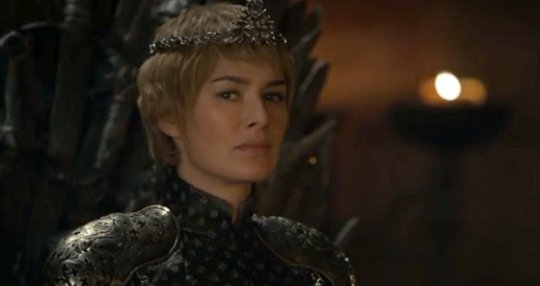
If it weren’t for the fact the Queen’s unofficial moniker is Grimhilde and her transformation scene reveals a head of black hair, I’d suspect her real name was Cersei Lannister.
You also have to remember that the Queen takes the term “fairest” at face value. The Queen is beautiful, sure, but it’s a glacial beauty – cold, unfeeling, and nothing beneath the surface. All she cares about is looks and power. You’d have to be a pure loving soul or Woody Allen find something worthwhile in her. Snow White is beautiful too, though it’s her kindness and fair treatment of everyone that garners her the title of “fairest one of all”, not her appearance.
Speaking of, we follow that scene with Snow White (Adriana Casselotti) dressed in rags cleaning the castle courtyard. She shows her bird friends her wishing well and sings “I’m Wishing”, where she reveals her wish for her one true love to show up.
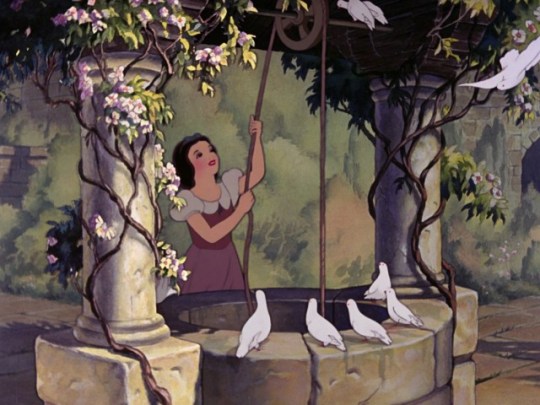
Confession time: In childhood the title of my favorite Disney princess was neck and neck between Belle from Beauty and the Beast and Snow White. I’ve already discussed at length why I adore Belle, so I suppose I should do the same for Snow.
…turns out it’s more difficult than I thought.
For as long as I could remember, I was surrounded by Snow White paraphernalia – tapes, toys, dolls, music, games, artwork, bed sheets, I can even recall the ice show. Snow White is ingrained into my early years. It more than likely has to do with the timing of its brief return to theaters and first VHS release between 1993 and 1994, right at the peak of the Disney Renaissance, so I experienced Snow White-mania right alongside Lion King-mania, Beauty and the Beast-mania and various other Disneymanias that were rampant at that time.

Even this one, embarrassingly.
As a result, I idolized Snow White as much the other princesses of the time, right down to making her the character I dressed up as the most for Halloween. I suppose what drew me to her was inherent kindness, ability to make friends with everyone, and her voice. Yes, I admit it. I don’t find Snow White’s warbling to be as irritating as everyone says it is. Maybe I’ve listened to it so much that I’ve grown immune. Then again I am that one Disney fan who doesn’t loathe It’s A Small World with every fiber of their being so maybe I should question my own tastes more.
Now as an adult with a critical eye who can put nostalgia behind me when necessary, is there something more to the character of Snow White that’s worth appreciating as much as the more-fleshed out princesses of the Renaissance and current Revival period?
I accept that I’m in the minority on this one, but I firmly say yes.
I know what you’re thinking – all Snow White does is smile and sing while she slaves under the Queen and the dwarfs and dreams of a handsome man to come carry her away, so I should turn in my feminist card for daring to suggest she’s a good character and role model for girls, right? Consider this: like Cinderella after her, Snow White’s happy nature and songs are her ways of coping with her unpleasant situation. It keeps her spirits up and in turn she tries to spread that positivity to others who need it as well. She refuses to let the Queen’s negativity turn her as sour as she is. All the little things Snow White reveals in what she does – her patience, pride in her work, healthy emotional balance, drive to help others, and warmth towards those smaller than her (in both a figurative and literal sense) – are all signs that she is capable of being a far better and beloved ruler and all around person than the Queen is. Plus, her reason for wanting to find love is two-fold: not only is she looking for someone with whom she can share a unique emotional understanding bond – which is something most every human craves – but it’s the also best possible means for her to escape from her stepmother’s abuse. Like I said earlier, once Snow White gets the ring, she gets to rule.
And what’s wrong with having a princess who can run a practical household? One could argue that it’s an example of traditional female roles desired by an oppressive patriarchal society on full display, but you want to know why millennials are called out for being lazy? Because baby boomers have cut out classes that teach things young adults actually need outside of school like how to properly cook and do laundry and pay your taxes since those weren’t seen as “essential enough to education”. So I have to admire a princess who, while not the most “progressive” of the bunch by today’s standards, is willing and able take care of herself and others when it comes to basic everyday needs. I think TheBrutallyHonestMom summed it up best in her post defending Snow White:
When we denigrate what Snow White accomplishes at the dwarfs’ cottage, when we rename her accomplishments to make them sound more impressive, more official, more valuable—management, administration, domestic CEO, sous chef, hospitality specialist—what we are really doing is saying that we don’t value the truly valuable work that she and so many other stay-at-home individuals do. Those words are a microaggression against what have traditionally been feminine roles, an attempt to align them with a patriarchal worldview where only those with the biggest titles and fattest paychecks matter. Snow White is domestic. She is a maid. She is a mother figure. She does take on the womanliest of the womanly roles. To claim that adopting these roles (and being good at them) somehow makes her a poor role model for my daughters is not a failure of Snow White’s imagination. It is a failure of ours.
Then there’s the matter of her actress too, which I can’t stay silent about. A few years ago it was revealed that in order to preserve the illusion of Snow White as a real character (a good many years before the company applied that same logic to their character performers at the theme parks I might add), Disney forced Adriana Casselotti to forego her screen credit and never take on another acting role again, essentially robbing her of a career. She only managed to appear in It’s A Wonderful Life and The Wizard of Oz because hers were uncredited minute parts. Casselotti had no regrets about choosing Snow White over a promising show business vocation, but I still call bull on the matter. If this kind of thing happened today, people would not stand for it, character illusions or not. There’s also crazy double standards since all the actors who played the dwarfs got to keep on acting; Sneezy’s voice actor was in Fun and Fancy Free for crying out loud! I love ya Walt, but that is one dick move. So if you’re a detractor cheering that you never have to hear Casselotti’s voice beyond this movie, keep in mind that’s all because of one man silencing her for the sake of his business.
So, Snow White. She cooks, cleans, delegates, teaches, loves, domestically kicks ass, and her behind the scenes story makes a strong case for the Time’s Up movement. Any questions?

“Yes. You’re over 2000 words in and we haven’t even gotten to the dwarfs yet. Plan on getting off that soapbox sometime this decade?”
Snow’s singing attracts the attention of a handsome Prince (Harry Stockwell) passing by on his horse. But his forwardness startles the shy girl and sends her sprinting up to her room. He charms her out to her balcony by singing his one song in the feature…”One Song”. You gotta love it when the title matches the tune perfectly.
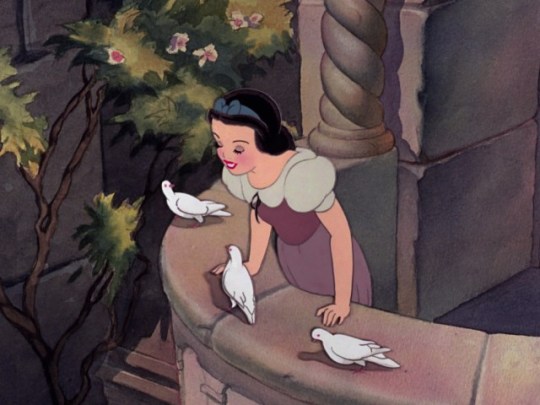
“Wherefore art thou Prince? Deny thy father and refuse thy name!”

“Sure I’ll gladly refuse my name – if I had one, that is.”
All joking aside, I have a soft spot for this scene. Stockwell’s voice has this old-time Broadway/operetta quality I’ve always liked, the lyrics are unironic purple prose that still feel genuine, Snow’s little excited gestures are adorable, and it’s framed beautifully. This is what got it into my heard early on that the most romantic gesture anyone can make is serenading someone from beneath their balcony.

“Too bad you’re technically in a long distance relationship.”

“I know. Propping up a phone beneath your window just doesn’t have the same effect.”
Snow returns his affections with a kiss delivered via a dove and departs the scene with one hell of a pair of bedroom eyes, especially for a Disney character.
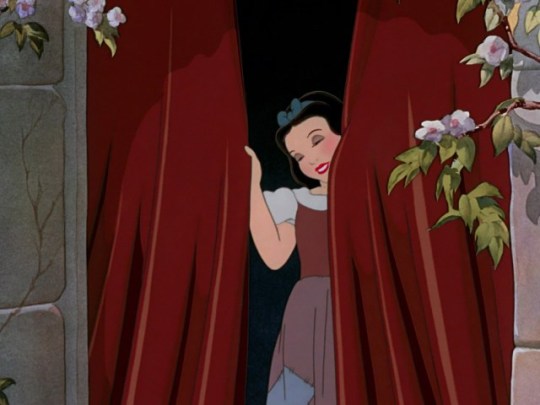
Daaaaaamn, girl! You already got him hooked, no need to gild the lily!
Unbeknownst to either of them, the Queen is watching overhead; Snow catching the eye of Prince Charming is what finally pushes her to take further action. She summons her Huntsman –
– to bring Snow White out into the forest and do away with her. Brief as this scene may be, there are two things I really like about it. First, the gravity. The Huntsman reacts with horror on being told what he must do, foreshadowing his eventual turnaround, yet with an icy hiss of “Silence!” and a short reminder of the price of failure, the Queen goads him back into line. We don’t know what the penalty for insubordination is, but it’s implied to be pretty nasty if she’s able to convince him otherwise with just a few words. Second, the Queen’s other demand. In the original fairytale, the Queen requested Snow White’s liver, lungs and heart so she could eat them and inherit her stepdaughter’s comely attributes.
youtube
But here in the film, she only wants the heart, and not for lunch. The Queen wants to keep it as a trophy. She even has a disturbingly appropriate box for it at the ready.
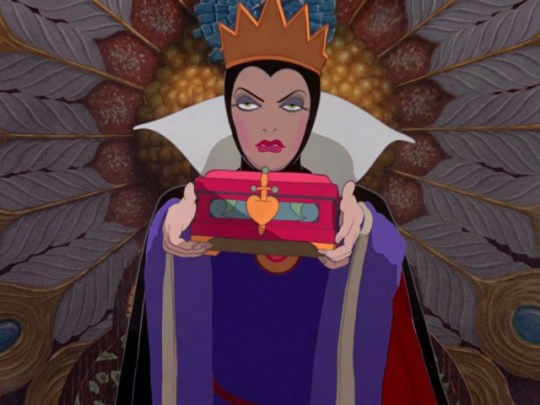
Proof that she really puts the ‘grim’ in ‘Grimhilde’.
Snow White, now dressed in her iconic yellow and blue dress, goes out flower picking with the Huntsman waiting not far behind. She spies a lost baby bird, and the moment she turns her back to help it, the Huntsman moves in for the kill. It’s framed like the murderer creeping up to their next victim in a scary movie, slowly building up to the moment he confronts her, with tension you could cut with a – well, you know.
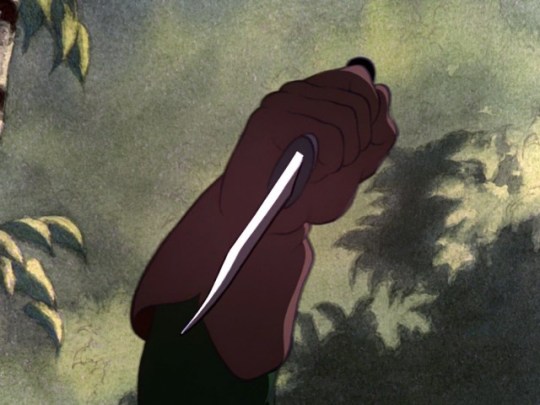
Ultimately the Huntsman is moved by the princess’ humanity and can’t go through with the deed. Instead he reveals the Queen’s plot and pleads her to run, run away, Snow, and never return. Terrified, Snow White flees into the forest where her fears magnify her surroundings. Brambles become gnarled outstretched hands, logs are hungry snapping crocodiles, and there are eyes everywhere, always watching, boring into her every place she turns.
I should note that while developing Snow White, the Disney studio became something of an art college with fine arts and film study classes offered to the staff in order to hone their craft. Some of the movies they studied were horror flicks from the pre-Hays Code era, classics directed by the likes of James Whale and F.W. Murnau. The results speak for themselves. Scenes like this and the Queen’s transformation are why I consider Snow White my very first horror movie. The frightening imagery and darker themes all hide beneath a veneer of Disney childhood innocence. Like a proto-Pan’s Labyrinth, the terror as much psychological as it is fantastical.
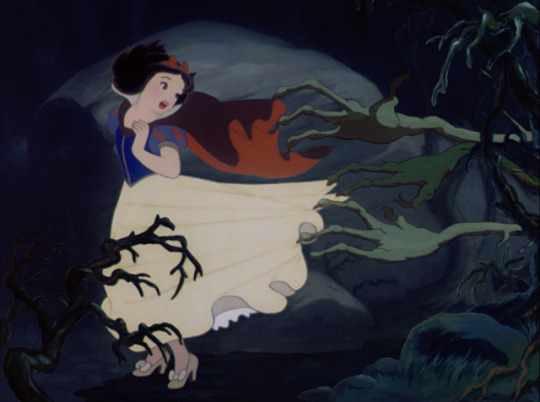
A young Sam Raimi watched this and vowed one day he’d make those trees even more terrifying and bad-touchy.
This scene is also the source of one of the most famous stories to come out of the film’s creation. During the planning of the part where Snow falls backwards through an open-mouthed cavern into a lake, one of the animators cried out in terror “Won’t that kill her??” And the whole room fell silent. They reached the point where they no longer thought of Snow White as a cartoon but as an actual person, something that had never happened before. That was the moment where they were officially, as Ben Vereen once put it, on the right track.
Overwhelmed, Snow White collapses in tears. She’s brought back to her senses by the usual cuddly forest inhabitants inexplicably drawn to female royalty in need of assistance. Of course, being the ever-thoughtful soul that she is, Snow apologizes for startling them and making a fuss over how afraid she was, once more putting others before herself. She bonds with the animals through the uplifting “With a Smile and a Song”. Then she spends several minutes talking to them and making plans for the future all in rhyme. I confess it’s one of the weaker moments of the movie, showing that the studio’s transition from the Silly Symphonies to full-fledged filmmaking hasn’t completely been made yet.
The critters lead Snow to a quaint cottage in need of a good cleaning service. Assuming the miniature-sized furniture means the inhabitants are orphaned children, she decides to surprise them by sprucing up the joint, hoping her act of kindness will make them forget her breaking and entering and they’ll let her stay. Said cleanup time is underscored by one of the more upbeat tunes in Disney’s songbook, “Whistle While You Work”. Like Mary Poppin’s “A Spoonful of Sugar” it’s all about finding joy in the little things that make the work go by quicker.
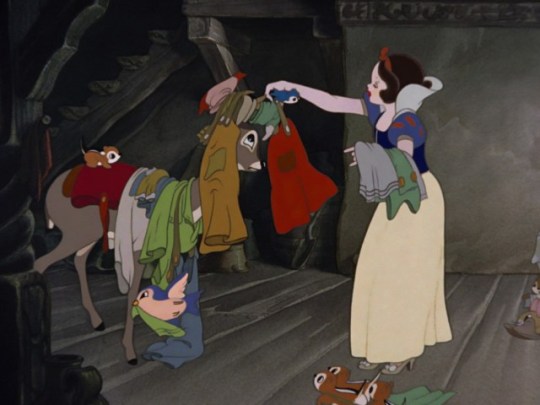
“Here’s the last of the underwear, Bambi. And try not leave any ticks in the laundry this time!”
But as we all know, the cottage belongs not to seven children, but seven little people who work as jewel miners, all the while singing that famous mining song –
youtube

“No, the one sung by dwarves.”
youtube

“Seriously?!”
All joking aside, Heigh-Ho is the best song in the movie, no contest. Easily the catchiest tune here if not the entire Disney canon. If it can keep a theater full of gremlins occupied, it’s doing something right.

Sure, they whistle while they work for now. But once they find the Arkenstone it’s all downhill from here.
And let’s not kid ourselves, the dwarfs are the real reason why we keep returning to Snow White. Their quirk-matching names and designs make each one memorable, they’re endlessly entertaining, and they’re the characters that come the closest to having some form of arc. The group is a prime example of the illusion of life that is animation, exaggerated to a degree that they’re still believable in their movements and mannerisms. Dopey especially works well in this regard, a wonder considering much of his character was developed by happy accident. When an actor suitable enough couldn’t be found, they made the decision to simply mute him. Like much of Disney’s favorite animal sidekicks, they based his personality around that of a lovable dog, though I’d be lying if I didn’t see some Harpo Marx in there as well. As a result, his childlike playfulness and comic timing is up there with Chaplin’s Little Tramp. His hitch step was also an unexpected boon; after animator Frank Thomas put it in one of his scenes, Walt liked it so much that he insisted all previously animated footage of Dopey be redone to include that step. Incidentally, Frank’s popularity among the animation staff reached all-time lows after that announcement.
Snow White flops down for a quick nap on the beds upstairs just as the dwarfs return home. What follows is them sneaking about their now suspiciously squeaky-clean cottage and further establishing their personas through a series of finely-tuned gags (Walt paid five dollars for every good joke his guys could come up with, and this was when five dollars could take you out to dinner and a show). Dopey is elected to check the bedroom and he comes to the conclusion that Snow’s sleeping form is a monster. The dwarfs work up their courage to go kill the beast themselves only to realize in the nick of time that it’s just a harmless girl. But Grumpy, the clear-cut misogynist in the group, isn’t keen on having a “wicked-wiled” female refugee in their abode and shamelessly yells “Let ‘er wake up, she don’t belong here no-how!”
Snow wakes up and instantly charms over everyone except Grumpy as they introduce each other. The dwarfs are shocked and terrified to learn the Queen has put a hit out on her. Grumpy in particular declares the Queen is a powerful witch skilled in the black arts, which is true, and it raises a potent question. Is her magic common knowledge throughout the kingdom, or is it mere speculation? If it’s the former, how did that come to be? What happened to Snow White’s father the king anyhow? All this could make for a very interesting –

“You know what, never mind, forget I said it -“

“Too late! Jenkins, write that down! Bob’s gonna love it!”
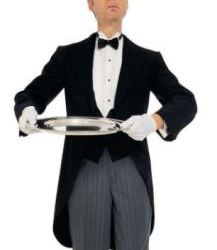
“Very good, sir. Shall I pre-heat your crack pipe in preparation for the first draft writing session?”

“Does the Academy loathe streaming services? Hop to it, my man!”

“Hey, I thought you left that jerk to go work for Don Bluth.”

“Shh! I jumped ship after A Troll in Central Park and came back under a new identity. I couldn’t pass up the bankroll Disney’s been on since 2009.”

“Mum’s the word.”
Grumpy’s certain that they’ll be in the Queen’s crosshairs once she learns they’ve been harboring Snow White and demands they kick her out at once. But Snow White stands up for herself and says she can take care of the house for them if they let her stay. Just like Belle offering herself in her father’s place, no one corners Snow into the position of housekeeper. She’s the one who puts herself out there, listing all her best qualities like she’s on an interview. It’s only when she does so (and also mentions she can bake a mean gooseberry pie) that the dwarfs overrule Grumpy and declare she’s welcome in their home.
Yet even when all is said and done, Snow makes it clear that if she’s the one doing the work, then the dwarfs must play by her rules. Immediately following their acceptance, she goes into full Team Mom mode, insisting they improve their manners and wash themselves before dinner’s ready. Doc attempts to get around it by saying they cleaned up “recently”, but despite her sweet nature, Snow won’t let them walk all over her. She does a cleanliness inspection that makes the dwarfs almost as bashful as Bashful himself, and even gets a good bit of sarcasm in (“Why Doc, I’m surprised.”) The dwarfs washing themselves is another one of those Silly Symphony-esque filler scenes, but at least it gives us more time for their fun shenanigans; though I have to wonder if dog piling Grumpy and half-drowning him takes it too far.
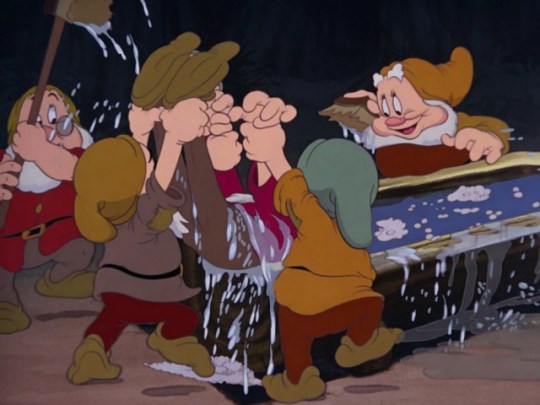
“Where’s the money, Legrumpski? Where’s the fucking money??” “It’s down there somewhere, lemme take another look.”
Back at the castle, the Queen is showing off her newly acquired bodily organ to the Magic Mirror while demanding he validate her preconceptions of who’s fair and who’s not. Alas, the Mirror tattles on Snow White’s location and reveals that heart belonged to a pig, which I’ve got to say I’m glad they didn’t show how the Huntsman got ahold of.


Infuriated, the Queen storms down to her secret lab (and no, there’s no wrong lever scene. I’m disappointed too). She brews up a potion made up of ingredients like scream of fright, a thunderbolt and partially hydrogenated dimethylpolysiloxane which will completely transform her into a disguise nobody could suspect her in, an aged peddler woman.
Was I afraid of this scene way back when? Of course, but it was one of those rare moments where I didn’t want to look away either. Here we have a woman dangerously obsessed with beauty becoming the very thing she loathes in order to sate her implacable desires. Not only that but in this disguise she’s able to set loose the insanity buried deep beneath her frigid calculating exterior, grinning and cackling like the witch that she is. The Queen never smiles once when she’s in her true form. But once she’s the old Hag and it’s all cackling and gap-toothed smiles, it’s extremely unnerving.
Case in point.

“Anyone else miss the creepy fade to black where the villain’s eyes remain for a few seconds? Disney needs to bring that back.”
Major props to Lucille LaVerne, who gives a bone chilling and utterly unrecognizable performance as BOTH the Queen and the Hag. She made the switch from one role to the next by removing her false teeth between recording sessions. In doing so she gave us one of the great Disney villain performances.
The part where she preps the infamous poisoned apple does undercut some of her menace, however. The Hag is supposed to be sharing her scheming with a cowardly raven, but due to how much she stares directly into the camera while monologuing, it comes off as directly addressing the audience, like we’re watching her in a play. It’s not just the Silly Symphony style of storytelling creeping in, it’s melodramatic semi-vaudevillian theatrics that early Hollywood was moving well away from at this point. And again, what’s with the sudden speaking in rhyme?
At the last moment the Hag looks up a possible antidote to the poison and learns that it’s Love’s First Kiss. However she scoffs at the notion that Snow White can be saved because she’s counting on the dwarfs believing the princess is dead and burying her alive.

“For those of you who claim Disney waters down fairy tales into saccharine pap, I point you to Snow White.”
And it doesn’t end there. As the Hag leaves the dungeons, she passes a cell where a skeleton is sprawled out between the bars, reaching for a water pitcher. It’s bad enough to imagine this poor soul dying of thirst, spending their last moments with salvation just out of their grasp, but the Hag openly mocks the skeleton and kicks the pitcher aside. If that’s not a deciding irredeemably evil factor moment, it comes pretty darn close.
This would have also tied into an important but ultimately scrapped sequence where the Queen kidnaps the Prince, locks him in the dungeon to keep him from saving Snow White and torments him by detailing her elaborate scheme.
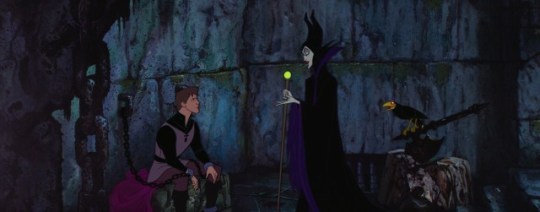
This sounds vaguely familiar…
Depending on which pitch you’re reading, the Prince refuses the Queen’s offer of marriage, and she enchants the chained-up skeletons of other scorned suitors to dance in an extremely misguided attempt keep him entertained while she’s out, or floods the dungeon to drown him. He makes a daring escape and rides to the rescue on horseback.
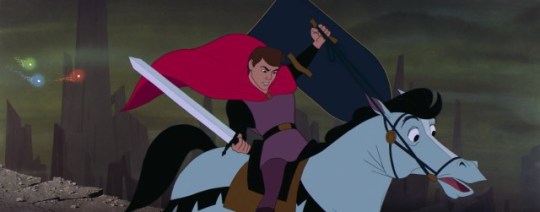
Again, vaguely familiar…
Unfortunately we had to wait twenty-plus years for this to happen because the animators weren’t confident in their abilities to create a believable male character. This is why the Prince appears only in the beginning and the end of the movie (and by extension why the Cinderella’s Prince is barely in that feature as well). When it came to making Snow White look realistic, they subtly incorporated some rotoscoping in a few places (I’d call it cheating but it’s difficult to tell where it begins or ends because she looks that good eighty years later). But I guess it just wasn’t worth the effort to do the same for her love interest, who doesn’t even get the dignity of an official name (fans go back and forth between Florian and Ferdinand). He’s reduced to a deus ex machina – which to be fair is exactly how he was treated in the fairytale. The movie has the slight advantage over that, however, by setting him up before he arrives for that wake-up kiss.

“And now it’s time for Silly Songs With Happy, the part of the review where Happy comes out and sings a silly song. Today’s interlude, appropriately titled “The Silly Song”, features choreography which has gone on to inspire many other Disney musical sequences dating as far ahead as the 70’s.”
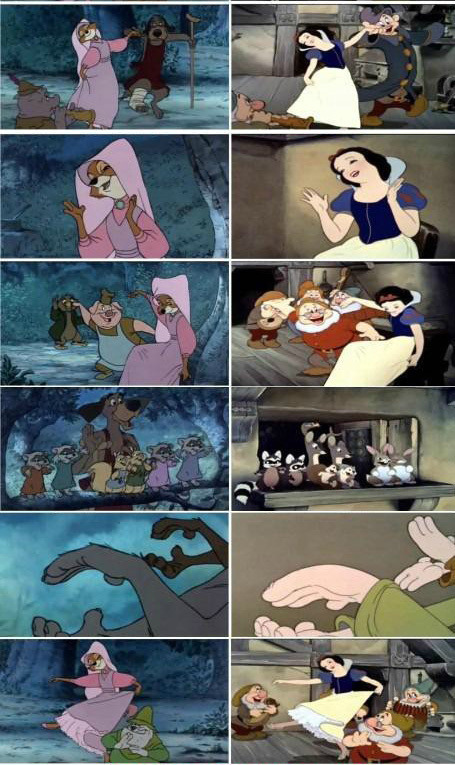

“Hold it!! It’s just the exact same movements with the Robin Hood cast grafted over them!”
“Is there a problem with that?”

“Well…no…it’s just a bit distracting when you finally notice it. I mean I love Disney’s Robin Hood, but boy did they take the main character’s attitude towards stealing to heart when it came to the animation.”
And yes, “The Silly Song” itself is fun too. It’s one of the less remembered Disney tunes, though I have fond memories of it due to its inclusion in the Sing-Along video lineup. The decision to have it follow the Hag’s unsettling introduction makes perfect sense; I could imagine audiences experiencing it for the first time needed a bit of a breather after that.
I guess I should mention the musical number we could have had instead of this one, though. “Music in Your Soup” was a similarly lighthearted song that was fully recorded and animated before it was ultimately cut. It was expertly animated, featured more dwarf-Snow White interactions, and it also closed up a plot hole involving a bar of soap Dopey swallowed earlier. Still, it didn’t add much to the story overall and it disrupted the flow, and keeping both that and “The Silly Song” would have been superfluous; so as much as I like “Music In Your Soup” I think they made the right call in sticking with “The Silly Song”.
After the dancing, Snow regales the dwarfs with a love story, though they quickly figure out she’s talking about herself and her prince. She dispenses with the self-insert fanfiction and sings the movie’s eleven o’clock number “Someday My Prince Will Come”. Bawl all you want about setting women’s rights back a decade, it doesn’t change the fact that it’s still a lovely song, even without Casselotti’s vocals. In fact, much of the movie’s soundtrack has been a go-to for jazz artists through the decades ranging from Miles Davis to Dave Brubeck. The pure simplicity of Larry Morey’s lyrics and Frank Churchill’s melodies are ripe for riffing on. Virtually every cover I’ve found succeeds in the impossible task of measuring up to the original in some capacity. The action in the song itself is subtle and restrained, mainly focusing on the dwarfs’ reactions. It’s not only good storytelling, but a clever way to get around showing more of Snow White than the animators could handle; she was already tough enough to animate even with rotoscoping.
Snow realizes how late it’s getting and ushers the dwarfs to bed; however Doc and the others try to behave like gentlemen and allow her to sleep upstairs while they take up whatever space they can fill on the lower floor. It goes to show how much her kindness and politeness has had an influence on them, at least while she’s around. Them taking up whatever sleeping space they can find on the ground floor is an excuse to squeeze more gags in, but I’m fond of how it lets us wind down and take in this cozy atmosphere.
The next morning before they head out the dwarfs warn Snow White to beware of strangers. Even Grumpy can’t help but show concern in his own gruff tsundere way. It’s little touches like this that reveal Snow White’s unwavering compassion is chipping away at his chauvinist attitude and he really does care about her after all –
Hang on, they couldn’t spare ONE dwarf to stick around and keep an eye out in case the Queen does drop by? They’re really think the Queen isn’t going to make another murder attempt as soon as possible? They sadly must, because no sooner do the dwarfs heigh-ho off to work than the Hag creeps up like a meth user turned Jehovah’s Witness.
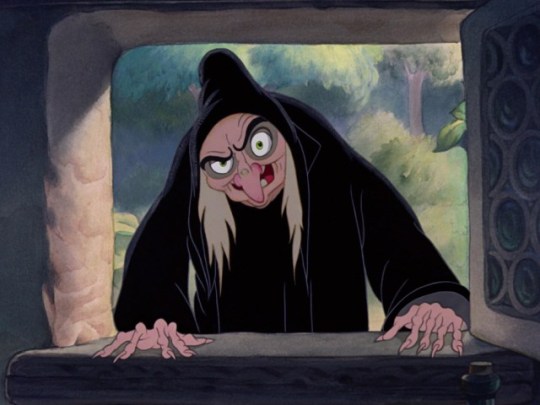
“Hello, my name is Elder Grim. Would you care to learn more about our lord and savior Chernabog?”
After the animals fail to communicate the obvious danger, they fetch the dwarfs for help. Meanwhile the Hag has convinced Snow White to let her into the cottage and show off her “magic wishing apple”.
Already I can hear the slapping of a thousand facepalms through my screen. I get why, but there’s something about the situation that feels strangely relatable. The Queen is fully aware of Snow White’s gentle, trusting nature and knows how to take full advantage of the girl. Snow isn’t all smiles and open arms though. There’s a split second of regret the moment she divulges she’s by herself, and as the Hag literally corners her into tasting the poison apple her body language gives away how uncomfortable she is. Even the cottage itself grows darker and claustrophobic, mirroring her trapped state. Snow White knows there’s definitely something off about this stranger, but there’s the downside of her kind personality. She can’t bring herself to kick the old lady out no matter how wrong this scenario inherently feels.
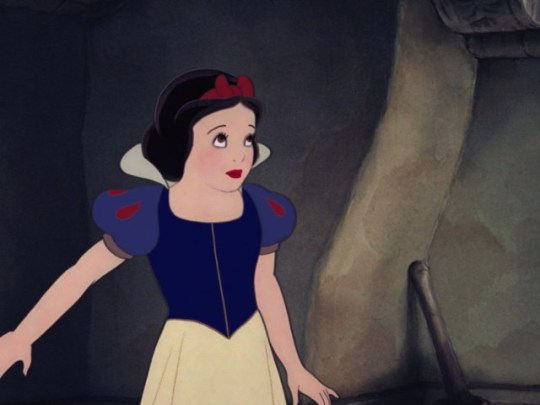
“Just keep smiling and slowly reach for the mace.”
Ultimately the Hag coaxes her into tasting the apple. Every breath leading up to it is dramatically intercut with the dwarfs led by Grumpy (further proof Snow White really has gotten through to the old softie) racing back to the cottage.
Do you want to know why the original Texas Chainsaw Massacre is considered one of the scariest movies of all time? Because for all its promise of a gory spectacular, the violence is deliberately kept offscreen. Our imaginations fill in the blanks and come up with even worse terrors than they could possibly show. Snow White’s poisoning works on that logic. All we hear is her gasping and groaning as the Hag gleefully looks on, ending with the most cinematic shot of the film.

If you’re still convinced Snow’s a dunce for biting the big apple, trust me, it’s a vast improvement over the original. The Queen showed up in disguise three times to kill Snow White with varying methods: strangulation by laces, a poisoned comb, and of course the apple. This was cut down to the last one for obvious reasons – not only would the story be repetitive and extremely padded if they remained, but it makes Snow White look like an idiot for falling for the same trap thrice in a row. The only time I’ve ever seen the inclusion of all three murder attempts work is in the anime The Legend of Snow White (which despite the laughably bad English dub is worth checking out). By the time the Queen comes around with the apple in that instance, Snow White is well aware of who she’s dealing with. But she plays along because the Queen has turned the kingdom to stone, and the only way to break the curse is by taking the bait and destroying her staff while she thinks she’s down, thus turning what was once an act of naivete into a heroic sacrifice.
The Hag exits the cottage feeling confident in who’s the fairest now just in time for the dwarfs to show up. They chase her through a thunderstorm up a cliff side. Literally trapped between a rock and a hard place, she attempts to dislodge a boulder and crush her pursuers. But Zeus is having none of that and a lightning bolt strikes the cliff, plummeting the Hag to her doom.
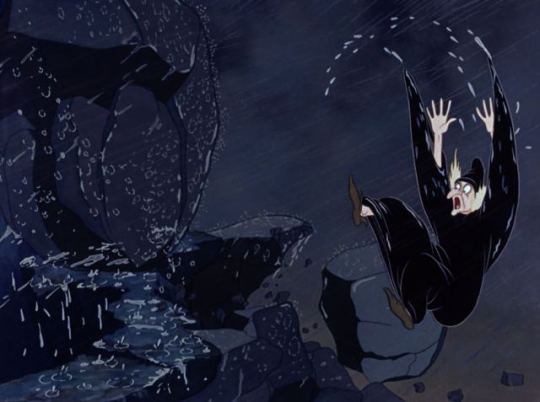
To quote Linkara, “Thus the origin for ‘Rocks fall, everybody dies’.”
And in case you’re still thinking she could have survived that drop, even with that boulder tilting over after her, the vultures that have been tailing her since she left the castle begin circling lower and lower over the place where she now lies. A chilling, subtle way to show they’re getting a meal after all.
We fade to a wake the dwarfs are holding for Snow White, complete with organ music and weeping – LOTS of sad, silent, motionless weeping. Poor Grumpy gets the worst of it. One can only imagine the tsunami of emotion he must have felt coming home to see that she was making a pie just for him. Like “Someday My Prince Will Come” it shows how restraint can be an asset in acting for animation. Considering how it’s very much like a real-life wake and just how much everyone believes Snow White is truly dead, this was a tough scene to get through.
The seasons pass and we’re told through title cards that the dwarfs couldn’t find it in themselves to bury Snow White, so they built a glass coffin and kept constant vigil along with the depressed forest animals.

“Clearly the idea of watching her slowly decompose over time never crossed their little minds.”
The funeral on top of the wake keeps piling on the sadness. We’re used to animated features moving us to tears, but you have to remember for audiences back then this was an entirely new experience because no animation dared to get this heavy. Think about it: Shirley Temple, Charlie Chaplin, the best and the brightest of Hollywood who poo-pooed Walt for his ridiculous idea – all moved to tears over Snow White. I can only imagine the satisfaction Walt must have felt hearing their sobbing at the premiere. Again, going back to that animator who felt genuine fear for her safety, the audience developed an emotional bond with the character just as they would for a real human on screen.
The Prince FINALLY shows up again still singing his One Song. Believing the love he has long searched for to be lost to him forever, he says his final farewell by bestowing her with Love’s First Kiss.
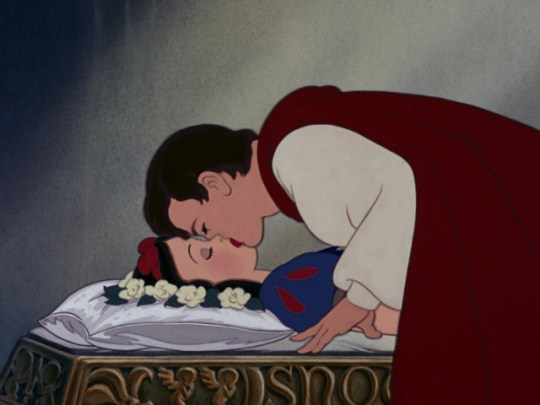

“Ah – “
“If you make ONE necrophilia joke, I swear I’ll take all the Adam Sandler movies off the Shelf.”
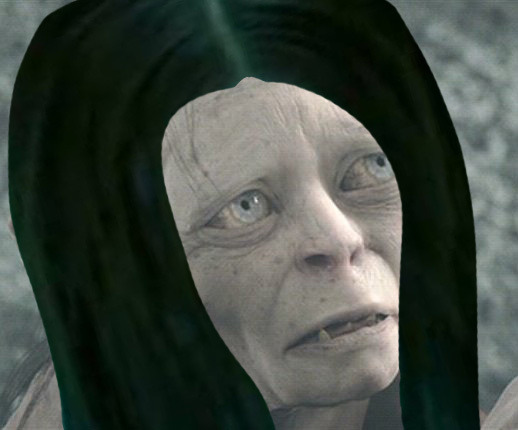
“Please, no!! I’ll have nothing to fully snark at!!”
The kiss does its work and Snow White awakens none the worse for wear. And since what doesn’t kill you makes you stronger, she’s immune to all poison ingested via deciduous fruit now. That’ll make ruling the kingdom she’s inherited from her stepmother and disappeared father much easier. And for those of you complaining how a magical kiss is a cop out, trust me, it’s better than how the original fairytale resolved it.
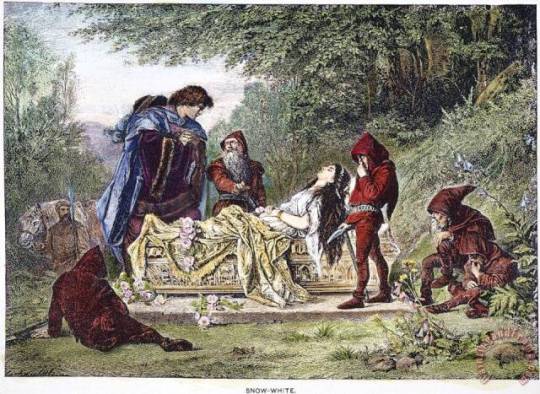
“Somewhere my love lies sleeping, and here she is! I’ll pay you dwarfs anything to let me take her back to my castle and keep her there as a memento of our tragic love.”

“This had better be worth it, she weighs a freaking ton!” “OHH, there goes my hernia!” *BANG*
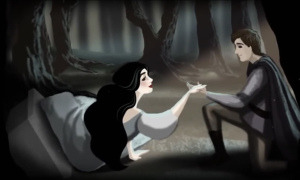
*HACKHACKCOUGHHACK* “Thanks for the Heimlich, guys, damn apple’s been stuck in my throat for a year!”

“Seriously, I’m not making that up. Plus, they invite the Queen to the wedding and force her to dance to death in red-hot iron shoes.”
Everyone rejoices, Snow White says goodbye to the dwarfs, and the Prince leads her on his horse to his shining palace in the clouds. They all live happily ever after, the end.
And that’s Snow White and the Seven Dwarfs, the very first animated Disney movie. Do I believe the American Film Institute’s claims that it’s the best animated film of all time? Well, to be honest, no. The main characters aren’t as developed compared to future Disney protagonists, the animation goes noticeably off model at times, and it’s got one foot stuck in the style of the Silly Symphonies shorts that came before.
Is it the most influential animated film, however? Of course! Without it animation wouldn’t be as mainstream as it is today. While the formula has been updated and subverted through the decades, most animated features follow a similar blueprint – a dastardly villain, fun side characters, memorable music, distinct visual flair, fighting, torture, true love, miracles, you get the picture. We wouldn’t have any of that without Snow White. Once upon a time, this movie was the Star Wars of its era; a groundbreaking, audience-thrilling blockbuster that changed the way people looked at movies. Part of that is because Snow White taps into an emotional simplicity in a manner few films are able to. It relies more on providing an emotional catharsis than logic, inviting us to experience the story as we once did through the eyes of a child, and in doing so captures the essence of a classic fairy tale.
In fact, looking at the ripple effect of how movies can influence one another across the years, Snow White ranks among one of the most influential movies made in general. Apart from Disney you can see its echoes in The Wizard of Oz, Gulliver’s Travels, Citizen Kane, and yes, the original Star Wars. Even Sergei Eisenstein, the man who revolutionized filmmaking with freaking Battleship Potemkin, declared Snow White to be the greatest film ever made.
…So why did Walt Disney come to hate it later on in life?
Every movie that’s met with acclaim and accolades is bound to hit some backlash for one reason or another. Maybe it’s been overhyped, or time hasn’t been that kind to it. For Walt, Snow White leaned into the latter as his artistic prowess grew. No creator likes looking at their past work because it’s easier to notice the flaws when viewing it through a more experienced eye (believe me, I know). That, and no matter what he did, it seemed impossible to escape from Snow White’s shadow. For decades everything he created was inevitably compared to it.
Hmm, the animation and music are an improvement, but what it’s really missing are some dwarfs.
Hmm, the creativity leaps off the charts, but if only the score had lyrics that rhyme with the words “shmeigh shmo”.
Hmm, it’s breathtaking and magical, but it’d be perfect if you could just sit and watch it for eighty minutes without interacting with any of it at all.
Hmm, it’s practically perfect in every way, but…um…uh…more dwarfs, dammit!!
Thankfully Walt’s displeasure mellowed after some time. As for Snow White, she’s still rightfully hailed as the one that started it all. The art is iconic, the characters are unforgettable, and virtually all the songs are Disney gold standards for a reason. Well before Rodgers and Hammerstein changed the face of musical theater by having the score and the book go hand in hand, Snow White did it first in the cinemas. In fact this was the first movie to ever have a commercially released soundtrack, another confounded idea Hollywood wouldn’t understand for quite a while. Though time may temper with modern expectations, Snow White is as much a classic now as it was destined to be eighty years ago, and nothing can touch it. It still is the fairest one of all.

“HA! Try to remake/sequelize THAT, Disney!”
“Excuse me, is it too late to join this review?”

“I’m sorry, who are you?”
“Oh, where are my manners? I’m Snow White’s sister, Rose Red.”

“…You sure you’re not just a color-swapped OC clone from Deviantart?”
“Of course I’m not, silly! I’m in the fairytale and everything! Well, not THE fairytale per se, but there is one titled ‘Snow White and Rose Red’ where we’re siblings.”

“Checks out. They’re technically related.”

“Okay, but what are you doing here?”
“I was just wondering when you were going to discuss my upcoming movie!”

“Your…movie?”
“Oh yes! It’s going to be Disney’s Snow White all over again but from MY point of view! Isn’t that exciting?”

“But…but you weren’t even in Snow White and the Seven Dwarfs.”
“I know! I was off to the side doing…well, you’ll have to wait and see! The lady who wrote that Gone Girl knockoff that takes place on a train and the Indecent Proposal remake is doing the screenplay and she is just delightful!”

“…Excuse me for one moment.”
“Oh dear. Have I said something wrong?”

“It’s ok. This is just the part of the review where Shelf goes berserk.”
youtube
Thank you for reading! If you enjoyed this review, please consider supporting me on Patreon. Special thanks to Amelia Jones and Gordhan Ranaj for their contributions.
You can vote for what movie you want me to look at next by leaving it in the comments or emailing me at [email protected]. Remember, you can only vote once a month. The list of movies available to vote for are under “What’s On the Shelf”.
Also, Patreon supporters get extra votes among other perks. If I reach the goal of $100, I can get back to reviewing animated series! I’m at the halfway mark right now, so please consider supporting me if you’re able.
Artwork by Charles Moss.
Most screencaps courtesy of animationscreencaps.com.
February Review: Snow White and the Seven Dwarfs (1937) If there's a reason why we're able to recall the story of Snow White from memory, and why said princess is usually depicted with short hair, a cute bow and surrounded by woodland fauna, look no further than Disney.
#1930&039;s#animated#animated feature#animated movie#animated movie review#animated musical#animation#bashful#buddle-uddle-um-dum#castle#classic#classic disney#classic Hollywood#dark forest#diamond mine#Disney#disney animated#disney animated feature#disney animated movie#disney animation#disney princess#disney review#disney villain#disney villain death#doc#dopey#dwarfs#evil magic#evil queen#fairest one of all
3 notes
·
View notes
Photo
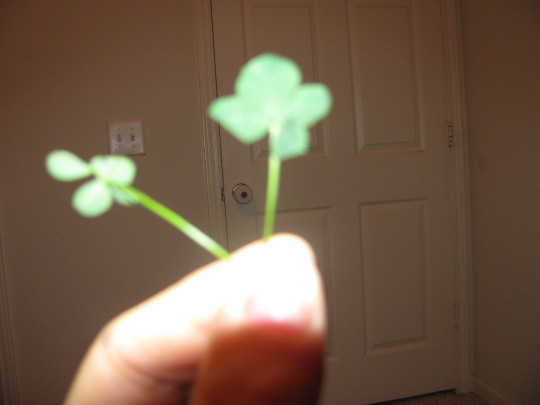
Here are the two clovers that I found back whenever, several years ago. I realized in this picture it’s a little hard to see the fourth leaf on one of them, but oh well. I saved this one in my draft folder and I like it because of the imagery, in which one clover overlaps the light switch, and the other one overlays the door. It makes me think, continuing on the whole idea of omens and good luck and beliefs, which have an ability to create good luck,... It brings me a few thoughts on those things.
Ok first of all let me also say that I don’t actually think that clovers are lucky, but you know, it’s just for fun, and as for what charms I think are lucky, well, I think that they are something imbued with spiritual or psychic energy, so it’s not so much the object but the message it gives or the person who give it to you or the message God is trying to lead you to, or the path that the symbol represents, that you are being led towards, be it a spiritual path or maybe just some other blessed path for you. In itself, I’m not a believer in a good luck charm that just has inherent worth as an object with some mystical power. Not that I say it can’t ever be, because I’m not totally sure. The world is mysterious. But I have experienced the luck of things that have real spiritual value because they are good messages from beyond, from higher, from God, I think. Then again I think that sometimes they can mislead, and be bad omens. False signs and wonders. I have experienced things of this nature too, that I thought were good until gradually, subtly it was revealed to me to be harmful. Enough good that I thought it was only good, but a subtle yet powerful bad effect was worse, though unseen.
Anyway, I think that even among good beliefs, sometimes they can be good only situationally. Just like a good, strong, solid, consistent, simple and clear story, it is good if it works for you, but it seems to me like not only does it have to be a simple, clear, strong basic story. It even has to be predictable, relatable, not too far outside what you are used to doing and feeling and thinking. Ask people to reach too far outside themselves and they will overlook the message. It goes back again to how children’s stories and folktales and fairytales can often contain what cultural sophisticated, high art, religious, and philosophical type stories omit,...
It’s as if there is something that more modernized mindsets lose touch with and children and people who have been less modernized are more likely to see these things, even when they have to veil the messages in hints, symbols and characters very indirectly, animals and fools and such that are silly enough to just laugh at, not too close for comfort, not too similar to the real problems they are hinting at or the deep truths many would laugh or deny or hide because it gets too real, too radical, too challenging, too brave, too good, for the mediocrity of average existence to accept or embrace, too hard, too fine a line to balance.
It seems that people have to oversimplify and they have to consolidate power in a few official people in power, within modernized, simplified, streamlined, organized, complex cultures and societies. Complexity and organization ends up helping in some ways and cutting corners and fitting us into a box that fits the overall system in other ways. I think that people in general want someone to help make life simpler, and in that process they seek the authority figures, the ones in power to simplify it all down to something they can say is the answer, the final answer, and if they have an authority who makes it all simple and lines it all out that relieves the uncertainty. This particular facet isn’t just for modernized societies. We have always been trying to appease the gods who have certain rules, in all cultures, through time, and we make rules and superstitions we are supposed to follow in order to seek the peace and harmony safe from the chaos that life rains down on us.
Anyway, there often is a certain order, sequence, hierarchy and so on in all these rules and rhythms and practices too, oftentimes. It’s the problem I have now. They say, do one thing before you can do another, but sometimes, maybe too often, I think, the order is arbitrary and false, harmful.
But anyway, people want an order to follow step by step, but I can see now its wrong for me,... Right now, in my case, I am dealing with this in my life with some of the religious beliefs in the path I’m considering. Again and again they say you have to do this before you do that, and I just cannot for my sanity.
So I can see these orders and sequences are sometimes just once more a problem of artificial, arbitrary order, to relieve the huge uncertainty and fear and sadness and pain and guilt because of all the mistakes we make when we are left to our own devices so we seek this outer authority to tell us exactly how, when, where, what and in what order we must do things, but sometimes they get the details wrong. But if we feel secure in our system we can feel like we are safe when we follow the proscribed plan and judge those who don’t and advise them and appease our conscience when others fail- it must be just a lesson from God for not following some rule, seen or unseen. But since there is so much we can’t know about others’ inner lives we can’t really truly judge (they say), but still many people do judge and you can see in how they act, many signs give it away that many do judge. It’s hard to have so complex a system of rules which are supposed to give all kinds of rewards, when followed well enough, eventually,... It’s hard to have such a set of rules without judging those who don't’ follow or who seem to endlessly suffer too badly. Then logic seems to suggest maybe they are not following the rules well enough and judgment follows.
Anyway though, the light switch, the door, in the picture, makes me think of things. Signs and beliefs can turn on the light, to a new idea, like a lightbulb, wake us up, make us pay attention, focus, remember the idea, try to do something instead of just thinking about it, take it more seriously. Then there is the door, the door to the actual new path, the new place, the new experience. Sometimes signs or beliefs just make the light come on, and sometimes they actually open the door to a new way. Some ideas do one thing, and other ideas do the other thing, some are lights, some are doors, some can be both or either. But a light doesn’t have to be perfect, it can be dimly lit, it can be a lamp that has a shape, a color, a form, that seems to be one way, but it shows us something else, when we see with the light that emits from the lamp. The door, the actual path, too, can lead from one path to another. But it’s more important for the door to lead at least in the general direction. Lights can be suggestions, possibilities, sparks of thought that lead from one to another to another idea. But real world action is more challenging and engaging, effortful and slow, oftentimes, and so that is when we really must be going the right way at least a little bit.
Or, maybe sometimes not, I guess, it depends. Because thoughts aren’t so free, so easy, a light that lights the way by making us think and figure it out and explore... Yes on the one hand thoughts can speed much more rapidly than real life actions can plod forward, but for the same reason they can delude us. Sometimes we will avoid nonsense by thinking so much and questioning and contemplating before diving into the action of life. Sometimes by using our minds and hearts, we can reach God and love and goodness and meaning without ever taking much “real world action”, and then the energy of our hearts and prayers reaches others even if we never leave our home. So many spiritual paths say, this path I’m considering, and Buddhist and Hindu, among other paths I’ve heard of. But thoughts can be very dangerous, quickly leading us blindly astray when we thought we were going somewhere good,... Keeping us trapped years on end, or decades, spinning in chaos. As I know, living through this for many horrible years of my life. Thoughts definitely can get us so lost, entangled, running faster and faster, unable to rest, restless, anxious, sad, confused, deluded. So there’s no rule I guess. Thoughts have to be at least somewhat good too or they’ll lead you way off track. You can’t always see for your own self what is good, true, makes sense, even if you’re smart, raised with good values, good enough, pretty good values (good as average, or I think in many ways much better than average, the values I was raised with). I should know because I was so lost that way in my mind. I think my desire to be a good person (figure out how and just what that really means in a world where so many opposing ideas of what is right and good and what is not and my own personality and physical and mental health problems were not at all fitting in with what almost anyone accepted to be “good”), all that made me lost, truly. And my desire to seek God and my deep thinking wrapped me even more in confusion than a simpler person who doesn’t try as hard to be as good, to reach as high, to find God, to make sense of the mysteries of the universe. Someone like my husband, as he was after he abandoned his spiritual interests, he was thenafter happy to abuse others (me), content in a simple life, apparently happy for all the world to see, strong and well he has been and continues to be.
And sometimes real action when misguided still teaches us very well what to do instead, in clear obvious ways. Sometimes real action is learning what mere ideas cannot teach. Sometimes real life is down to earth and full of observable, experienced facts that keep you in the realm of safety and goodness. And real actions can often include meaningful, human interactions that keep you in the fabric of life and what really matters. But other times even real experiences and interactions just seems meaningless, forgettable, trivial and numbing, a rushing around, an artificial appearance and the praise and admiration of others, all for nothing, or their scorn, and advice, but again, misguiding, all for nothing. I don’t know.
More roundabout thoughts, circular but I feel they’re leading somewhere that matters, to help me sort out why religion keeps tangling me up rather than resolving into clarity, oftentimes.
0 notes
Note
Re your post about shipping and r3ylo.. You mentioned you could guess from marketing where they might be going, do you mind sharing what you think? I’m just curious :) esp since you’re a filmmaker
Oh, haha, I’m not actually a filmmaker; it is one of my life plans and I love picking apart stories to see how they tick, and how I could work some of those elements into my own, but I have yet to write or direct a feature.
But nevertheless…
(TLJ SPOILERS AHEAD)
…
If I were to channel my younger self (back when I idolized the most predictable plots ever, thanks to my mostly fairytale-based upbringing) I would say that this sort of yin/yang, opposites-attract, beauty-and-the-beast tale of redemption and hope would absolutely make sense.
- platonic love in Star Wars -
Now, I don’t know if this means that they’re going for a R/K romance; I would definitely prefer if they didn’t, especially given that Kylo Ren is frankly a monster, and all of Star Wars’ romances have made me cringe so far.
In fact, I loved how Rogue One ended without a kiss; the only real romance of that movie was the sort of old-married-couple camaraderie of Chirrut Imwe and Baze Malbus.
I think Star Wars works better when it’s focused on familial themes, and keeps pairings platonic; just think of how much love exists between Luke and Leia, vs. Han and Leia. Perhaps I’m misreading the writers’ intentions, but that moment when Rose told Finn that she saved him because his life is worth more than sacrificing himself to take out the cannon (maybe a lesson she learned from losing her sister?) felt similar to Rey and Finn’s hug in The Force Awakens, or Jyn Erso and Cassian Andor’s embrace towards the end of Rogue One: warm, platonic, and full of affection or comfort. The way I interpreted it, Rose was so weak that hugging Finn was out of the question, so she mustered her strength for a small kiss instead.
- opposites attract / beauty and the beast -
The K/R relationship, on the other hand, reads a lot less like that kind of familial affection, and more like two characters whose destinies and identities are closely intertwined. If Star Wars had prophecies (…does it?), they would feature in one. They are opposites: light and dark, each trying to tug the other towards their side.
This also connects to the beauty-and-the-beast archetype that we love to repeat in fantasy romances: the good, pure woman believes that the flawed, violent monster is capable of being saved, and through her love he is able to redeem himself and become fully human.
This can be a problematic trope, especially since it’s usually framed so that the woman forgives the man’s abuse; nevertheless, it provides a compelling amount of angst and pining, which often resonates strongly with audiences. (Popular examples include the Dr@rry ship, which tugs on many readers’ heartstrings due to the combination of suppressed feelings + outward antagonism; the enemies-to-lovers trope in fanfic; or Elizabeth Bennet and Mr. Darcy’s relationship arc in Pride and Prejudice.) Conflict is often more compelling than simple, honest love… and Star Wars’ most famous romance, between Han and Leia, is proof that the franchise has a fondness for this kind of love-hate tension.
- yin and yang -
Now, I am not really a hardcore Star Wars fan and so I might be forgetting something, but from what I can remember, Star Wars has never really done this kind of two-character dichotomy before, which is a little surprising given that it’s a franchise based around these very yin/yang principles of light vs. dark. If they have, it’s been between a good character and a bad character; Luke Skywalker and Darth Vader, perhaps. Light and Dark are seen as opposites, and sort of by extension, good and evil/the Empire and the Rebels are that dichotomy. With Rey and Kylo Ren, there is potential for one (or both) to switch sides; Rey is untrained, and has the potential for darkness (Luke appears to be scared of her power in the trailer), while Kylo Ren is introduced in The Force Awakens as having an internal struggle that hints at the possibility of a redemption arc. They are two sides of the same coin.
(However, from what I understand, traditionally, yin and yang do not reflect good and evil. If yin and yang are two opposing forces that exist in everything, balancing them creates peace; therefore, “peace” cannot be one of the two forces, with “violence” as its opposite – and so “good” cannot be a force, with “evil” as its opposite.
This is particularly interesting when you consider the codebreaker’s point in The Last Jedi, that both sides power the same machine. Both sides use violence against the other, to restore their vision of order to the galaxy; the First Order’s happens to include genocide, but regardless of their moral purity, neither side technically embodies “peace.” So in that sense, they aren’t really opposites on the yin/yang scale.)
Despite this, Star Wars generally frames Light vs. Dark as synonymous with good vs. bad, so I suppose we can still interpret these as being two opposites of the yin/yang variety. So, for the sake of our purposes, yin is Dark/bad, and yang is Light/good.
- the Force as a midpoint between two opposites -
Luke teaches Rey that the Force is not something to be used by either side as a tool, but is instead the force that exists between all opposites – this implies that Force sensitive people are not inherently light/good or dark/evil, and make that choice individually. Rey makes this connection directly when she tells Luke that he was wrong to conclude that Kylo Ren needed to be stopped; she argued that his choice was not yet made… but our two characters view their status as Force-sensitive people in different ways:
Rey interprets this as proof that Kylo Ren has the potential to choose to join the Light side, despite his current status on the Dark side; she sees the conflict within him as a temporary state that can be fixed through his conversion.
On the other hand, Kylo Ren interprets the separation of the Force from either end of the spectrum as proof that he and Rey can exit the system entirely, “leave it all behind,” choosing neither the Light/Rebellion nor the Dark/First Order.
Kylo Ren sees that the two sides tug on each other and create endless conflict, in the same way that he and Rey tugged on the lightsaber and split it in two; he wants to resolve his internal conflict by rejecting the system entirely, and he wants to do that with Rey. Without her, he has no one.
- Kylo Ren’s reasons for wanting Rey to join him -
One of the biggest insights into the difference between Kylo Ren and Rey comes when he tells her that nobody cares about her except for him.
First of all, this statement is objectively inaccurate. Finn, Han, Leia, and Chewbacca have all shown fondness for Rey in the first film alone.
What he really means is that he has nobody who cares about him, except for her. Snoke and Hux treat him like garbage, his underlings probably hate him, he’s killed his father, estranged himself from his mother and uncle, and could never really go back and face them even if they forgave him, what with the guilt from all the people he’s murdered.
But she seems to care. What with their mental Force-Skype connection, and with her alternating between “you’re a monster” and “I saw the conflict in you” [there’s potential for goodness in you], he believes that maybe, just maybe, she might understand and sympathize with him. And he’s isolated himself for so long that he probably interprets this as love. (Hence the cringe-y shirtless scene, which I suppose was his attempt at a physical seduction…?? I guess taking his helmet off in The Force Awakens didn’t excite her enough, so he went all-in and tried to seduce her with the PG-13 equivalent of a dick pick.)
He thinks that maybe she could love him, and that would be enough, and he could leave his shitty past behind and not be alone. He acknowledges that he’s a monster, because he knows that he is; he’s just holding out hope that she will forgive him for his sins, because she keeps talking about how he can still be saved… but the problem is that while his idea of balance (the Force) is a balance between Light and Dark, good and evil, her idea of balance is the peace that will come from a Resistance victory. She wants him to resolve his internal conflict by choosing Light over Dark.
- what Rey wants from Kylo Ren -
I think that the main problem with this ship (as a possible direction for them to go; ignoring what I think about it personally) is that it’s pretty one-sided, and based on unhealthy principles. Rey doesn’t want Kylo Ren in a romantic light at all; he’s mind-raped her, killed her surrogate father-figure (who was his own father, adding to her revulsion at his morality), is a major part of the First Order that has terrorized her world and her friend Finn, has almost killed her friend Finn (remember, she doesn’t know that Finn has woken up), and failed Luke.
Rey wants to save Kylo Ren because she believes that it is the right thing to do, not because she has feelings for him. She thinks that if she can convert a major player on the Dark side to the Resistance, the First Order will be weakened, enabling a Resistance victory. She also might want to prove to Luke that he didn’t fail in his teachings.
- will Kylo Ren convert to the Light side? -
Look at what Kylo Ren does when Rey rejects his offer to go with him and leave the Resistance/First Order conflict behind: he tells Hux that she killed Snoke, then takes command of the First Order and resumes his campaign against the remaining Resistance forces. He fights Luke. Let’s be honest, even though the trailer made it look like he was going to start acting on some hidden inner goodness (hesitating when faced with shooting at Leia; the editing suggesting that Rey was asking him for guidance, rather than Luke), this film made it clear that there is only one thing that could make him turn down the Dark side: Rey.
So, what is the most plausible way to end this character arc?
Well, I see one of two options:
Rey continues to try to drag him away from the Dark side, and he accepts… but only because she has agreed to join him. From her perspective, it’s a personal sacrifice for the good of the Resistance; for him, it’s what he wants. The fight in the red room proved that if Rey is involved, he has the potential to fight against the Dark side. But without her, he immediately snaps back to the Dark like he’s a lightsaber and half of the jedi playing tug-of-war suddenly let go.
He ends the trilogy as a villain, on the Dark side. Now, while this makes sense from a real-world standpoint, I don’t know why they would have spent so much screen time focusing on his internal conflict between Light and Dark if he was just going to end up as a bad guy. Like, this took up most of Rey’s plotline in this film, and regardless of that will-she-accept-his-guidance tease from the trailer, I seriously doubt that Rey is going to turn to the Dark side.
So, since I assume they must have some reasoning behind this K/R storyline, and the amount of focus that has been placed on the two characters and their relationship (to the point of minimizing the role of Finn, who was arguably the main protagonist of The Force Awakens, or at least a co-protagonist, with Rey), I would guess that they’re going somewhere with this, and that somewhere just might be a romance. I would really appreciate it if they didn’t, though.
7 notes
·
View notes
Text
Extra Typology Vol #2 - 9. Another Take on the Hybrid Types
So, the hybrid types.
For those who didn’t join us in Vol #1, the main gist here is that some people don’t so much fit one of the 6 main types, but instead see to be situated somewhere ‘in-between’ on an integration line, resulting in 6 specific ‘hybrid types’ between each pair of ‘adjacent’ types, which is where the ‘12 type enneagram’ gets its epinomous 12 types from.
If you did read my thoughts on the last book, you might realize that there’s not really that much overlap between the descriptions, beyond what you’d expect from being derived from the main types (particularly with Lunar-Venus the contrast is stark as it plays them for opposites in terms of monogamy behavior) - which isn’t necessarily a contradiction as one thing the books agree on is that every hybrid type person will have a different ‘placement’ on the line between one type and the next, and will react exactly like one type in some situations/life areas and exactly like the other in others instead of being perfectly in between or randomly switching;
Personally, I think that the best approach here is to just describe the main types & let the ppl themselves decide “well im a bit like this with bits of that”, especially since the book even introduces the concept of what they call a ‘split’ type (a combination not on the standard lines), though with the usual ‘this is pretty rare & probably not you, just be honest with yourself about what your most fundamental traits are’ caveat.
Nonetheless, I will present some summaries of the portraits the author paints of the hybrid types, in case anyne finds this useful, relatable or interesting/inspiring.
Lunar-Venus
combines intuitive knowledge and emotional earthyness
however, this might be a somewhat vulnerable combination as they are neither fully grounded in lunar shredwness nor Venus responsibility
dreamy innocence meets sensuous charm
the kind to reblog a marilyn monroe quote
unabashed & refresing attitude about relationships & sexuality - may thus acquire plenty of experience, but also be tempted to unduly tie their self-worth to it
might charm their way up in the world but lack the skill & dilligence required to follow through and consistently keep a job, relationship, social circle etc. - easily attracts partners but might fail to keep them due to evenually retreating into lunar dreamyness & isolation
suited for jobs that are freelance or low on ‘homework’, like actors or waiters.
Venus-Mercury
Combines emotion and speed - active and social person, most likely an extrovert and/or soc first
practical and active but: may value order or expediency more than logic per se
free time is likely to be filled with very active hobbies others may find the opposite of relaxed
sensual & devoted partners but also very “out there”, not a homebody at all - partners should accept that they will spend plenty of times going out with their friends
common pitfalls include a tendency toward the flippant and superficial - think screwball comedy
feel a need to be liked/popular & likes compliment; Will discuss the feedback they get & tell everyone who said what about them
more likely to forgive & move on than a pure Venus - the people around them would do better to appreciate that than to force difficult discussions.
Mercury-Saturn
Combine speed and deep thought, a combination which is often prized & sucessfull these days
Not ‘deadly serious’, indeed, profound creative output might often be presented or packaged in an entertaining manner (”Dear, why is there a random flirting joke amid a treatise about the meaning of life?”)
bridge the personal and non-personal realm, might take up a position of support and then have trouble finding support for their own needs,
I personally know two individuals, both INTJ, & this does remarkably well describe common denominators between them, though I’d assing them different percentages. (as well as subtypes and 9gram types) Most INTJs are probably not all that mercury-ish socionics notes the ILI type for its relative inertia, this is probably more common among the more ‘deep’ ESTxs or some ENTPs, but, goes to show how this can be an idependent metric of sorts
Saturn-Mars
combine inherent gravitas with a sense of dominance or even supremacy; These are some intense fellows
in both social & personal life, these people will be gifted in terms of their actions, ambitions and persuading others to join their causes
often actors, politicians or generally very outspoken public figures
good at “reading the mood” in a room or society at all
compared to a pure Saturn they’ll be far less inquisitive for its own sake and more visibly opinionated, but they can write impressive and deeply though-out treatises, manifestos & political books (1984 anyone?)
cause-driven - serious people with serious goals
don’t believe in staying in the shadows and may indeed see charisma and celebrity as good for business
very driven, can be ruthless in pursuit of their goals
espouse their own views and relenentlessly deny & dismantle the truth of others while using their own encyclopedic knowledge
often sucessful but their self-promotion might backfire if it comes at the cost of ignoring others
seems like a soc-first 6 with 8 or 3 fixes
Mars-Jupiter
characterized by ‘benevolent forcefulness’
strongest of all combinations, tough, resilent & full of energy
which is good for them because they often have huge agendas on behalf of others
unlike in a pure Jovian, the desire to help isn’t tempered by an inclination to keep the peace - so they can come off as forceful and bossy
“I’m doing this for your own good”
basically Tumblr, especially the discourse
rejects as worthless what’s not up to personal standards
takes on daunting projects with little concern for personal safety - the type to be a protester or activist, or do charitable work in a warzone
all about ideals, less concerned with personal relationships that might end up playing a lesser role, though they’ll feel genuinely bad about any failings that may happen here as they’re generally well-wishing (think of all those often-divorced politicians)
changes mind easier than a pure Mars type, especially if they view the new idea/ belief as “even more just”
Jupiter-Lunar
The ‘fairytale friend’ - the strong, reliable ‘parental’ influence meets the innocent & childlike
their friends might be confosed as to wether they want to give support or be supported ( the answer is both, depending on context)
unlike a pure Lunar, they’re not so much ‘lost’ in a fantasy world as that they have a certain mastery over it
may have exotic beliefs because they see little distinction between it and the arbitraryness of reality (and often end up being prized in such groups as they’re willing to stick around for the boring administrative footwork others avoid)
disarms through their spontaniety - can be both very serious and excited/radiantfrom moment to moment
Matt Smith’s Eleventh Doctor comes to mind
often dreams or a family & kids that they’ll then relate to as both a benevolent guide and a friend
generally great with kids because they’re basically one themselves but, unlike a pure lunar, have the responsibility to handle the caretaking role
competency & work ethic will get them into a position of responsibility, but their own needs will be a mystery to themselves and others
mom friend
can both defer & guide but might be awkward in one-to-one equal interactions in both friendships and especially romantic contexts
“I want my beloved to be happy”
may step aside in favor of other candidates even if they cannot avoid becoming friends with a potential mate
use their complex inner world to relate & empasize with others in almost all situations, forging friendships & relationships even in situations others would see as dealbreakers (widower with 3 kids? No probs!)
benevolent to the point of naivity, often distraight & dissapointed by the wickedness of the world but just as good at finding things to be positive about
frustration tends to be vented inward, in private
gravitate toward jobs in charity or caretaking
usually both competent & fun
xNFP?
7 notes
·
View notes
Text
A Review of Shira Dentz's 'how do I net thee'
By Kathryn Cowles
Some books of poems have to teach you how to read them because you can’t read them any of the old ways. Some books, in addition to being about whatever they’re about, are also about improvising a new way of saying, and therefore require a new way of reading. Some books are an investigation of methodology even as they plow ahead, and this is true of Shira Dentz’s how do i net thee (Salmon Press, 2018). So before I get into the specifics of Dentz’s original, weird methodology and language, I want to posit a theory of the why behind the how—the thinking I see going on behind the doing that manifests in the many luminous and strange visual elements in the book. But just to make sure you don’t lose interest amidst the theorizing process, here are some juicy bits of language, completely decontextualized, to hook you in, many of them employing this poet’s characteristically startling figurative language or her characteristically complicated alliterative twists and turns:
“Sitting here opening chestnuts / one comes out like a coin” (61)
“His voice particular, the inside of a menorah. Silver and warm at the same time.” (52)
“a corseted idea / like sunrise and sunset” (6)
“desire yellow on the burner heat on low” (16)
“mother, / a brief flick in the air like light from a lighter / nod your lips curtain in a breeze” (8)
“a mouth inside herself” (38)
“let’s make some word water two parts salt one part light influenced by the moon junkie streamlined take a cup and fill it that lemon scent in the outdoors air a skirt of pine trees draped along mountains” (15)
“but when I eat, it’s a solid thing, like a right word” (58)
“Apples and whine the voice sublime toes and woes Schubert aglow the spine of tree leaves, mark trunk and bark in back of the crease keep me from falling hot springs dry cracked lips to the vine and back let it go take me the wind drapes like a cloth over my mind, a napkin on my lap.” (57)
So there you go—call it an appetizer.
The first poem in how do i net thee is kind of a bonus pre-poem, sneaked in before the table of contents, a clue into the framework of the book as a whole. The poem is a riffing on/recontextualizing of the OED definition of “net.” It begins and ends mid-sentence and winks at its own materiality, at its own doubling, its words bifurcating and proliferating and opening out. The poem ends like this:
to make by the process of producing network; to
interlace,
to take, catch, capture,
or gather
(This is as good a moment as any to note that all quotations here are approximations since these poems move all over the page and are therefore difficult to reduplicate in miniature. Dentz herself apparently co-designed the book, so it’s clear that spacing matters. Alas for me.)
You know how, when you push your thumb against a running faucet, far from stopping the water, you send it spraying in all different directions with increased force? In this book, Dentz’s poems activate their contents through pressure. They put their thumbs against faucets. Far from trying to settle their words into stable forms, these poems intentionally shake them up.
That first poem, hiding in plain sight before the book even quite begins, ends with a faucet moment of proliferation that could be an ars poetica for the larger project’s methodology.
I like the wild gradations of that take catch capture gather as it destabilizes the “net” from the book’s title. I like the idea of holding together multiple differing gestures at once, of tracking different configurations of the same words and their subsequent effects, of teaching readers to read in split and sometimes contradictory ways. I like building by interlace.
The difference between take and gather, for instance, the movement between, is startling. Take involves something done against-will, implies the creature one takes from, while gather suggests a passive and near-inanimate object, like wheat. Similarly, catch and capture run the gamut. One catches a frog, a small animal, perhaps using lures, bits of food, or subterfuge, but one captures a person, a fugitive, an enemy soldier, a flag, a whole kingdom.
take catch capture gather encapsulates the complex ethical terrain of any poetic gesture of writing-about. It implies an object in varying states of being-acted-against. It knows that there’s a violence inherent in the take catch capture gather-ing of a poetic object, and rather than ignoring it, it puts the violence on the surface of the gesture, makes it meta, makes it apparent to the reader. It finds a new way of writing—of netting the stuff of the world on the page—that performs this contradictory and fraught gesture and therefore empties it of some of its violence against the poetic object.
The ethical terrain of writing/roping something to the page is more fraught if the thing getting netted is a person, a thee rather than an it, like a beloved brother lost, or a perpetually wounding father, two of the central, haunting figures in how do i net thee. Thee is the language of the holy but also of childhood fairytales, and of troubadours, of “whom do i love best in the world” (from “X” 17). Thee is an intimacy but also a pedestal. Is adoration. Is a formal gesture, a performance. Thee calls attention to the fact that it calls attention to the fact of its subject, that it chooses the performance of its how. It puts its take catch capture gather on the surface of its gesture. It shows its cards.
Because there’s always an ethics embedded in poetic methodology. There’s always a netting taking place, even though many choose to bury it beneath the surface. To call attention to it, to put the thumb on the faucet, to give multiple different gatherings instead of just one, destabilizes the weighty authority of truth claims on the page. And indeed, these poems are interested less in Capital T Truth than versions, angles.
To this end, in a number of spots, Dentz will recreate entire earlier poems with no or few differences in word choice but with entirely different spacing on the page in order to call attention to the way spacing on the page affects the words gathered—to draw attention to the surface of the saying. These twinned poems are about what they’re about individually but also about an ethical destabilization, the fact that changing their spacing on the page changes the content, even when it’s otherwise identical or nearly identical, the fact that one can literally say the same thing in terms of word choice and yet not say the same thing.
Or, put another way, different configurations of the same poem can be like different kinds of maps of the same moment in time, each truthful in their own way—the way a topographical map versus a map of the train system of a place would look different, even if they hold the same content in terms of place. Catching the actual, physical world on the page can manifest itself in any number of different ways, each calling our attention to different details as the most important ones.
Dentz invents a number of other linguistic tactics, poetic tactics, spacial tactics that make this complicated, ethical gesture of take catch capture gather. For instance, her sentence edges sometimes get all slippery as they try to keep up with her thoughts (or her speaker’s thoughts; but let’s just problematically say her thoughts and call attention to the violence of it in a parenthetical note, wink). Conjoined-twins sentences, is what I started calling them in my mind.
Like “are they singing or laughing or clapping back to desire young young how do i net thee with my shredded heels no i don’t want to look humpty dumpty had a great fall for heaven sakes” (from “Anatomy” 16). Sentences overlap onto each other, as with that “look,” which can attached itself to “no i don’t want to look” or “no I don’t want to look humpty dumpty” but also “look humpty dumpty had a great fall for heaven sakes”. The effect is one of both immediacy and great speed. Of asking questions and sometimes answering them right after, and in real time, of finding out what one thinks via thinking it, form running hand in hand with content. This kind of writing nets, but spraypaints the net a bright and visible color.
It’s worth noting here that how do i net thee has a handful of pieces of pictures of net, I think culled literally from an image of a net inside the front cover, thrown in physically in the middle of poems, like little chutes from Chutes and Ladders games of my youth, further drawing attention to the materiality of the netting and also gathering/yoking words and pieces together that might otherwise be isolated. These pieces of net help pull the entire book together as project even as separate little poems go their separate ways.
Or consider the methodology for how things make their way into the poem “watercolor tongue” (19)—at the speed of thought: “yesterday bikes in a forest / with deer. would be perfect, a man. my head could / race, maybe did one too many now it’s coming back how i asked what’s / your schedule. i’ll have to look. why did i bother, brother, watermelon / claw, green shades of sunset flesh.” In these lines, we are moving through language that feels remarkably like thinking, with its diversion-ed momentum. We are in yesterday in a forest, and then now thinking of a man (“would be perfect, a man.”), then thinking about thinking (“it’s coming back now”), about the head racing, and then recounting the thing the speaker wants the mind not to race to, a conversation (“i asked what’s / your schedule. i’ll have to look. why did i bother”). And then the word bother, the look or sound of it, remarkably, turns to “brother,” to that thread of net, that chute, haunting the entire book, a lost brother whose voice is slipping out of memory. The way brother enters into the poem is the way things that haunt us enter into our thinking, mid-thought.
Or consider the methodology of strange metaphor and image progression in some poems, which is quintessential Dentz. The poem “Marsupium” begins, “A girl of freezing ice in my stomach; papoose; / skinning my meat” (4). The strange emotional precision of the embedded metaphors strikes me here. And yet the metaphors don’t settle into their equal signs. They wiggle and proliferate into further metaphor and so do a different kind of work:
i’m a basket of eels on the backseat of a car.
curled like question marks.
Am i the girl who makes the empty plank of a brother
white keys on the far ends of a piano
a baldness, with nothing around it
Silence
Vaseline on my senses
being angry comes in waves you see the flight pattern but no bird
Dentz frequently juxtaposes sharp image after sharp image in order to suggest a new grammar or logic or relationship between things, in order to constellate. The images accrue, they gather themselves into something cumulative, something akin to metaphor, but not exactly metaphor. It’s like a metaphor of feeling, images trying to get at some complex feeling, some other-side-of-an-equal-sign, from multiple angles. It’s metaphor in the process of take catch capture gather. The images are trying to get something from the world down on the page, and the something is not simplified. It refuses to be reduced in the netting process.
It’s hard for me to say just what this poem is doing to me and why I like what it’s doing so very much. It has both precision and expansiveness, switching lenses on me line by line so I see something both small and up close and then a whole larger landscape in a short amount of space.
I also like that it’s difficult poetry, to use that age-old, often problematically gendered term, and yet difficult in the service of something I can feel in my gut. It’s difficult on its textured surface but also tied to something that feels core and human. It gut punches via the intellect. This is a glimmering kind of balancing act indeed.
Because ultimately just saying something in a new way, and then getting meta and saying that you’re saying something in a new way, isn’t quite enough for me with a book of poems. Such a gesture alone doesn’t actually take catch capture gather at all. It doesn’t net anything; it just sews nets prettily or elaborately. It puts its finger on a conceptual faucet without turning on the water, without getting all wet. I do often like to find myself in the kinds of poems that are a purely intellectual enterprise, that make me think about language and how it operates, that delight me on a surface level with their twisty-turns.
But my very favorite poetry does something more. It asks “in the dark are there kind letters and if so which are they” (58). It delights with intellectual twisty-turns, yes, and strange methodologies, but it does so with an ethical, human anchor and purpose, with a beating heart, and in doing so, it turns me into something more than a passive subject. It take catch capture gathers me up and actually moves me, which is what I would ultimately say to describe how do i net thee: it moves me smartly, it transports me, intercepts, arrests, apprehends, gains possession of me, entangles, affects violently, seizes, snatches, grasps, lays hold of, grips, snags, hooks, it captivates. And good.
Kathryn Cowles is an associate professor of English at Hobart and William Smith Colleges in the Finger Lakes region of New York. Cowles’ first book of poems, Eleanor, Eleanor, not your real name, won the Brunsman Book Prize, and Cowles’ second book of poems, Maps and Transcripts of the Ordinary World, is forthcoming from Milkweed Editions. Cowles’ work has appeared recently in such places as New American Writing, The Georgia Review, Boston Review, Verse, Diagram, Best American Experimental Writing, and the Academy of American Poets Poem-a-day.
1 note
·
View note
Text
Hope Chest of Freedom
12- 21- 17 -
I have a hope chest, which was made by my grandfather, as he made for all his granddaughters. I suppose it wasn’t made with marriage only in mind, but of course, could be used in that light, saving things to take along, to the new home, quilts and linens and whatever things we wanted to store up,...
All this,... All stored up like a magical charm, a dream vision, a fairytale to build up... And hoping for some idyllic world of dreams, a home, a life... all that. Yes, nice but now I feel like it is freedom I want. I want to make a hope chest of freedom. I want to make it for my daughter and my own life, whether it is a compromised freedom, or a total freedom or a freedom in love, to fall in love, to know how to tall, not afraid of that, with someone who also knows how to fall and doesn’t own what isn’t theirs. No bridal dowry, no thing to sell myself, no thing to buy myself, either...
Simply instead, just a hope chest for the freedom I aspire towards. But I want this freedom more in a metaphorical sense, not that i have a lot of material things I am storing up and planning,.. More of ideas and values, perspectives I want to take with me, to have for myself.
A hope chest, a dowry, it is not just about buying a good husband, but also about the possibility of escaping, if the husband is bad,.. The means to free oneself, to thrive despite him, maybe... Even if you don’t get away. If you remain trapped but the riches and beauties you brought with you can give you some comfort and wellness and material abundance. These things are mainly things that are used by the woman, not for the man as much... Household goods, dishes, linens, fine embroidery and feminine finery and beautiful household decorations, etc. I feel it is a metaphor I can appreciate. Like a bridal dowry, it might be used all one’s life, like in some cultures and times, not only after marriage.
It’s the woman’s lot, her heirlooms, inheritance. It’s not something you have to compare and judge, hide or keep in a case, or reveal only as a bargaining thing for the man who wishes to wed the daughter,... Lol It’s not something that I have to hide, the things I use to buy my freedom, my love ,my joy,... As though my freedom, value, joy and happiness and wellbeing is to be compared or hidden... As though it’s shameful or not good enough,... As though anybody else has any right to question or criticize it. I want to just talk about it... This is my freedom, buying my freedom, as if I should have to, as if it should be bought and sold, as if it should have a price, but it does... So I have to do this little game, dance, proving, storing up for what should have been a birthright, earning as I go...
Like Schehezerade, buying my freedom, prolonging my freedom... by just delaying my execution,...
The things I use to calm the beastly murderous husband... These also feed myself...
That’s how I feel. I’m garnering riches, flourishing them, trying to make them seem special, like stories, like beautiful things, worth waiting and enjoying before killing or forcing me to follow the wishes and demands of others who would destroy me if I didn’t have that something to prove my value... Destroy heart and soul, not body, in my case... With neglect, refusal and rejection, denial... The same thing that buys my freedom also buys my joy and wellness...
So it is that ideas are freedom, stored up... And, like Schehezerade,... I live on stories... Lies, hopes and dreams, and distortions... Magical stories, miracles, spirit beings, spells and genies, wishes and deities’ grace. Stories, of beauty, sensuality, playfulness, silliness,... and of heart and love and ideals and justice to the righteous, of good endings for good people, and bad for the wrongful or foolish ones... Of which I try not to be like them, try to learn wisdom. Wisdom tales. Wisdom is knowledge, not love... Foolish can be loving and fall into disaster but I’m trying to have wits as well as love.
And so,... With feminine wits,... In prison weaving a web to freedom,... Climbing across the sky... Scattering my strands far and wide to the winds and many corners of life and reality.... And,..
Story after story to stave off the cruel, greedy, controlling, delusional “husband”, that is the things that control and abuse what is instead really sweet, light, innocent, playful, creative, childlike, pure.. Divine mother, Divine child, Divine Feminine, Divine masculine, when given it’s child aspect, I guess.....
A girl has to do what a girl has to do I guess... Sell herself, buy herself, work to earn her freedom from slavery in a society that doesn’t see her inherent right of freedom... Entertain the husband, the powerful, the might... Entertain and also bargain against the great hunt, death, gods, nature,... Inevitable power and might that is a fact of life...
This is just fine... I am happy with this because it is the choice to live, be grateful, make the most of it, enjoy life and try and earn freedom and so on... It’s the best a woman can do, and gives wisdom of the low places... Low places to observe, unnoticed, to be close to earth, close to god, instead of material might and height that falls like pride. Like power and wealth of money instead of riches of the heart...
Yes it’s what buys myself, whether buying another through their admiration and understanding and liking who I am, where my joy and heart is... Where my heart is, my treasure is.
It’s just as likely to buy myself and my daughter at lea the happiness we can find even if it’s a compromised partial freedom... But many who deem themselves free are only free in terms of material reality but not their hearts and passions and joys... Not their purposes and desires and hopes and drives and ambitions that burn strongly... Often purpose, ambition, love, desires, require sacrifice, compromise, and what looks like even imprisonment, pain, shame, but it’s not like it seems. Which,...
That is why women, often seen to be weak and small, cornered and controlled, often really held the reigns and the power of the heart, intuition, joy, raising children, the heart of the home and it’s comforts and its joys, friendship, open expressiveness... Etc,... It was their very controlled position that often let them be freer and more real and true, somehow...
Because, in some strange sense,... I think,... Without the power and accomplishment and control their hearts could know a power unseen or little recognized. And power over men, and their hearts and so on, often, from behind the scenes, far more often than is known.
0 notes